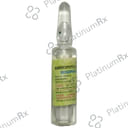Aminophylline
Uses
Aminophylline is used in the treatment and prevention of chronic obstructive pulmonary disease and asthma.
How it Works
Aminophylline is a bronchodilator that works by relaxing the muscles of the airways and widening them. This action makes breathing easier.
Side Effects
Common side effects of Aminophylline include nausea, vomiting, headache, insomnia (difficulty sleeping), restlessness, convulsions, gastrointestinal irritation, irritability, increased urine production, shakiness, increased gastric acid secretion, and gastroesophageal reflux disease.
Expert Advice
- You have been prescribed Aminophylline for the prevention and treatment of asthma and chronic obstructive pulmonary disease (COPD).
- It should be taken at the same time each day, preferably in the evening after food.
- Aminophylline does not work immediately and should not be used to relieve sudden breathing problems.
- Always keep a fast-acting (rescue) inhaler with you.
- Your doctor may conduct regular blood tests to monitor potassium levels and the concentration of this medication in your body.
- Notify your doctor if you have ever been diagnosed with kidney, liver, or heart disease, or if you have a history of smoking.
- Your dose may need to be adjusted based on your medical history.
- Do not discontinue use without consulting your doctor, even if you feel better.
Other Combinations
Aminophylline + Theophylline
Related Medications
Aminophylline 250mg

₹18.1
MRP ₹36.1
Aminophylline 250mg

₹22

₹18.1
MRP ₹36.1
Aminophylline 250mg

₹22

₹18.1
MRP ₹36.1
Aminophylline 250mg

₹16.4

₹18.1
MRP ₹36.1
Aminophylline 25mg

₹44
Aminophylline 125mg

₹29
Aminophylline 25mg

₹34
Aminophylline 225mg

₹71.4
Aminophylline 25mg

₹23
Aminophylline 25mg

₹20
Aminophylline 25mg

₹40
Aminophylline 350mg

₹71
Aminophylline NA + Theophylline NA

₹50